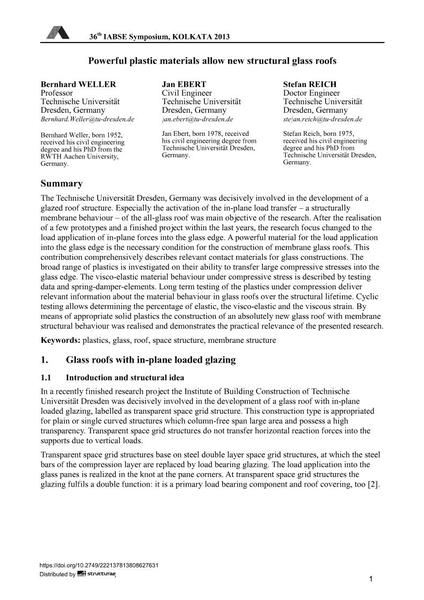Powerful plastic materials allow new structural glass roofs

|
|
|||||||||||
Détails bibliographiques
| Auteur(s): |
Bernhard Weller
Jan Ebert Stefan Reich |
||||
|---|---|---|---|---|---|
| Médium: | papier de conférence | ||||
| Langue(s): | anglais | ||||
| Conférence: | IABSE Symposium: Long Span Bridges and Roofs - Development, Design and Implementation, Kolkata, India, 24-27 September 2013 | ||||
| Publié dans: | IABSE Symposium Kolkata 2013 | ||||
|
|||||
| Page(s): | 1-8 | ||||
| Nombre total de pages (du PDF): | 8 | ||||
| Année: | 2013 | ||||
| DOI: | 10.2749/222137813808627631 | ||||
| Abstrait: |
The Technische Universität Dresden, Germany was decisively involved in the development of a glazed roof structure. Especially the activation of the in-plane load transfer – a structurally membrane behaviour – of the all-glass roof was main objective of the research. After the realisation of a few prototypes and a finished project within the last years, the research focus changed to the load application of in-plane forces into the glass edge. A powerful material for the load application into the glass edge is the necessary condition for the construction of membrane glass roofs. This contribution comprehensively describes relevant contact materials for glass constructions. The broad range of plastics is investigated on their ability to transfer large compressive stresses into the glass edge. The visco-elastic material behaviour under compressive stress is described by testing data and spring-damper-elements. Long term testing of the plastics under compression deliver relevant information about the material behaviour in glass roofs over the structural lifetime. Cyclic testing allows determining the percentage of elastic, the visco-elastic and the viscous strain. By means of appropriate solid plastics the construction of an absolutely new glass roof with membrane structural behaviour was realised and demonstrates the practical relevance of the presented research. |
||||
| Mots-clé: |
toit structure à membrane
|
||||
